Zoom is an online meeting tool with microphones, cameras, screen sharing, and a whole lot more that can create an opportunity for active learning with real time conversations. Many of the teaching practices that you utilize in a face-to-face physical classroom setting can be tweaked and used in a Zoom meeting.
As we transition over to Zoom across campus these instructions will be fluid and can change as we discover issues, new features are added, etc. We would love your help with keeping these pages as accurate as possible. If you notice an issue or something isn't behaving like it says it should in the instructions please let us know by completing our Academic Technology Support and Training form.
Learn how to access Zoom for use with Web Portal.
Learn how to create and schedule a Zoom meeting from with Web Portal.
Learn how to share Zoom meeting information from with Web Portal.
Learn how to start a Zoom meeting as the host from Web Portal.
Learn how to manage participants, share your screen, and use the chat tool in the Zoom toolbar.
Learn how to manage the participant list in a Zoom meeting.
Learn how to share your screen and documents in a Zoom meeting.
Learn how to access and export meeting and poll reports.
Zoom is not to be used for the transmission of patient data, or for any clinical needs, and host accounts will only be provided to Augusta University students, faculty and staff.
Learn how to access Zoom from the web portal.
You can use Zoom meetings strictly within your D2L course or using the Web Portal at zoom.augusta.edu.
Note: If you have created a free Zoom account in the past using your augusta.edu email you will need to follow the instructions for Existing Zoom Accounts.
Learn how to create and schedule a Zoom meeting from within Web Portal.
2. You will be taken to the Schedule a New Meeting page where you can begin to fill out the meeting options that you desire.
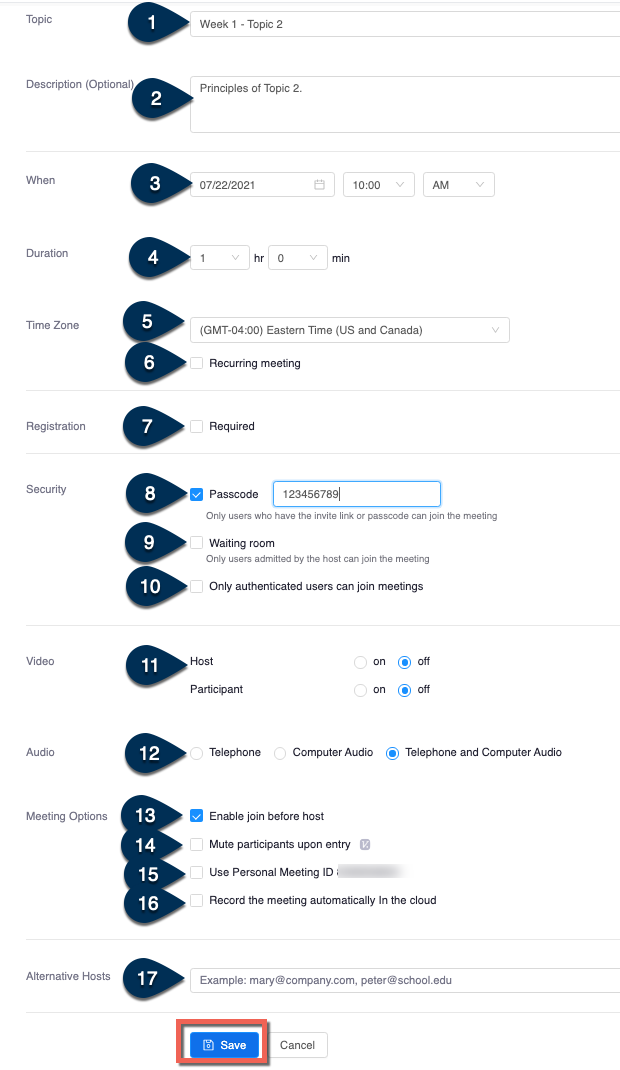
Topic: Enter in the name (or title) of the meeting. Note: Be very descriptive with the name of your meeting as it will stand out and be easier to notice in the Event Calendar widget within D2L.
Description: Enter in a description about the meeting. (This is optional)
When: Choose the date and time for the meeting. You can start your meeting at any time before the scheduled time.
Duration: Choose the approximate duration of the meeting. Note: This is only for scheduling purposes. The meeting will NOT end after this length of time
Time Zone: By default, Zoom will use your computer's time zone. Click on the drop-down to choose a different time zone.
Recurring Meeting: Choose if you would like a recurring meeting, i.e. the meeting ID will remain the same for each session. If checked, you will then have the options for Recurrence (Daily, Weekly, Monthly), Repeat every (Days/Weeks/Months), and End date (Specific date or 1-20 occurrences).
Registration: Allows you to have your participants register with their e-mail, name, other questions, and custom questions.
Host Video: Choose if you would like the host video on or off when joining the meeting. Even if you choose off, the host will have the options to start their video after joining the meeting.
Participant Video: Choose if you would like the participants' video on or off when joining the meeting. Even if you choose off, the participant will have the option to start their video after joining the meeting.
Audio Options: Choose what audio options you want to allow for the meeting (Telephone, Computer Audio, or Both)
Require Meeting Password: You can select and input your meeting password here. Participants joining the meeting via typing in your meeting ID will be required to input this password before joining your scheduled meeting. Those joining via the "join meeting URL" will not be required to enter the password as it is included in the link.
Enable Join Before Host: Allow participants to join the meeting without you (host) or before you (host) join.
Mute Participants Upon Entry: If join before host is not enabled, this will mute all participants as they join the meeting.
Use Personal Meeting ID: Check this if you want to use your Personal Meeting ID. If not selected, a random unique meeting ID will be generated.
Enable waiting room: Allows the host to control when participants join the meeting by placing them in a waiting room.
Record the meeting automatically: Check this if you want the meeting to be automatically recorded when you join the meeting as the host. You will have the option to record the meeting locally on your computer or in the cloud.
Alternative Hosts: Enter the email address of another Zoom user with a Pro license on your account to allow them to start the meeting in your absence.
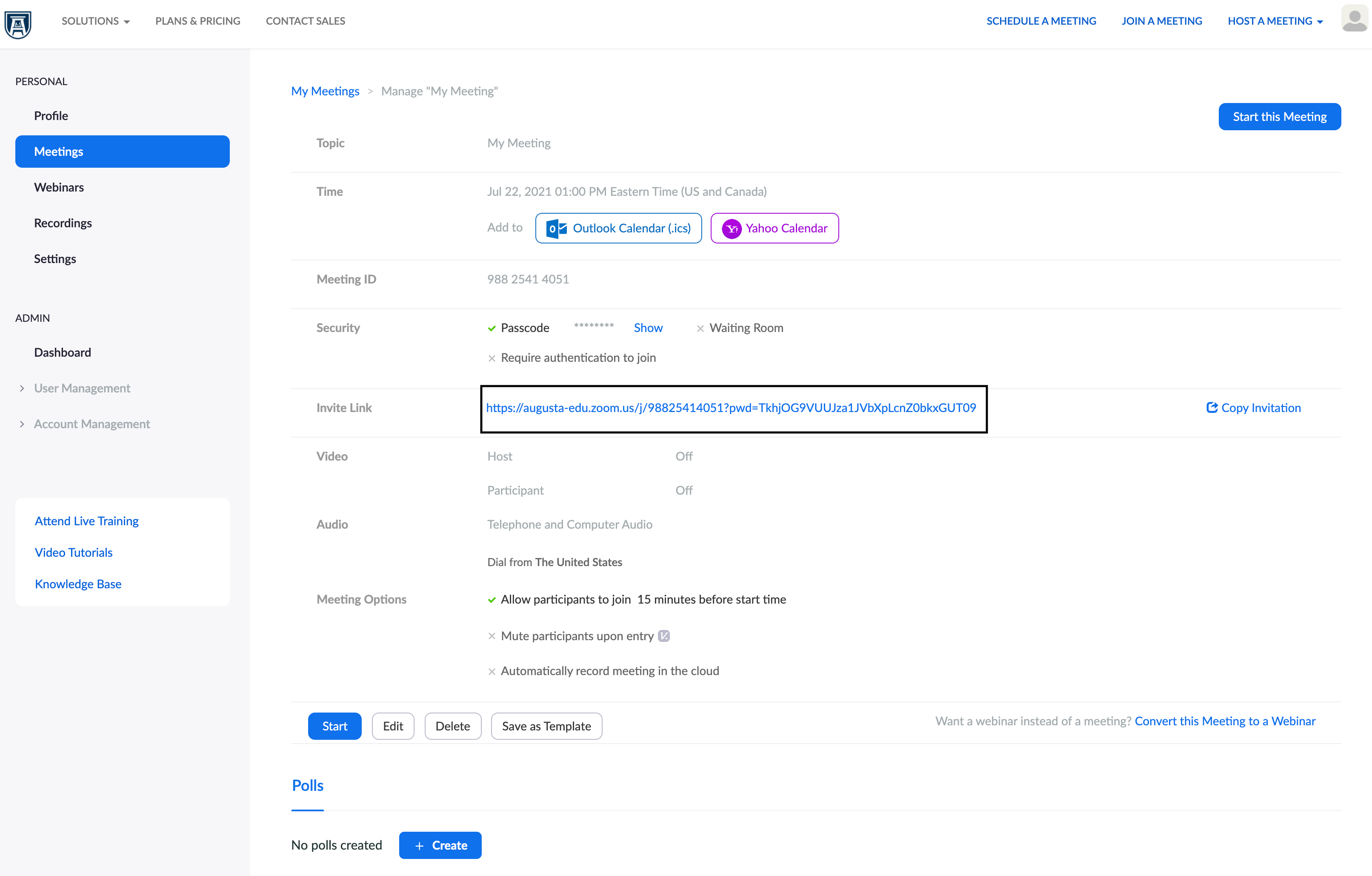
Learn how to share Zoom meeting information from Web Portal.
1. Sign into zoom.augusta.edu.
2. Click on the Meetings tab and find the meeting you need to share. Click on the meetings name. Example: Test meeting to share with others.

3. Scroll to Invite Link and at the far right, select Copy Invitation. Create an email or calendar invite to share with people who needs to attend the meeting.
Learn how to start a Zoom meeting as the host from Web Portal.

Once the Zoom app is installed on your computer it should launch the meeting. It will prompt you to choose which audio option you want to join the meeting with.
The default selected option is to join by Computer Audio. This option is always free and it works in the Zoom app for desktop as well as your smartphone mobile device app as well. You will just need a microphone (built-in, USB, or inline) as well as speakers or headphones. If you want to test your microphone and speakers before joining you can click the link that says Test Computer Mic & Speakers. If you'll always join Zoom meetings via the Computer Audio then you can check the box to Automatically join audio by computer when joining a meeting. Once you are ready to join by computer audio you'll just click the Join Audio Conference by Computer button.
The other audio option is to join via a Phone Call. You can join a Zoom meeting via teleconferencing/audio conferencing (using a traditional telephone). This is useful in occasions where:
For more detailed information about joining by teleconference/audio conferencing please visit zoom support.
Learn how to manage participants, share your screen, and use the chat tool in the Zoom toolbar.
Below you will learn about the different options you have within the host controls toolbar when you are in a Zoom meeting. You can also find more information about the host controls within a meeting at support.
Microphone: This button will Mute and Unmute your microphone. Also if you click the up arrow next to the mic icon you will have options to choose which microphone you want to use and which speakers you want to use. You will also have the option to leave the computer audio if you no longer want to use your computer audio for the meeting. You would then click Join Audio button that appears in the toolbar and choose to rejoin via Computer Audio or you could change to join by Phone Call. You can also pull up audio options from here if you want to test your microphone or speakers.
Video: This will start and stop your video camera feed if you have a video camera connected to your computer or through your smartphone or tablet. If you click the up arrow next to the video icon you can choose which camera you want to have selected (if you have multiple cameras connected) as well as choose other video settings.
Invite: Allows you to invite people into your meeting while the meeting is occurring. You can invite by email or you can invite a room system (H.323/SIP). You can also copy the URL of the meeting or copy the invitation of the meeting to send to someone.
Manage Participants: Clicking will open and close the participant window that shows you the list of participants who have joined your meeting. You have lots of other options within the participant list that will be covered in the Manage Participant List section.
Polls: Clicking this allows you to create, edit, and launch your polls. The options to create or launch polls will open up the Zoom web portal in your default browser. See the Polling section for more information.
Share Screen: This is where you can share your computer screen to the participants in your meeting. You will have the option to share your entire desktop screen, a whiteboard, an iPhone/iPad that you may have connected, or a specific window, document or application that you may have open on your desktop. If you click on the up arrow next to the Share Screen icon you can choose to set it to only "One participant can share at a time" or "Multiple participants can share simultaneously". You can also go into advanced sharing options where you can choose who can share (only host or all participants) and who can start sharing when someone else is sharing (only host or all participants). See the Sharing Your Screen section for more information.
Chat: Clicking will open and close the chat window where you can chat with all participants or to specific people. See the Chat Tool section for more information.
Record: Clicking this button will allow you to choose to record the meeting locally to your computer or to the cloud. See the Recording section for more information.
Breakout Rooms: Clicking this button will allow you to create breakout rooms to send your participants to for discussion and collaboration in smaller groups. See the Breakout Rooms section for more information.
End Meeting: Clicking this will prompt options to end the meeting. You'll get an option to "End Meeting for All" or "Leave Meeting" where only you will leave the meeting.
Note: If you are the host, you will need to assign someone else as host before you click Leave Meeting.
Learn how to manage the participant list in a Zoom meeting.
As the host of the meeting, you have lots of options regarding managing your participants.
To the right of each participant's name you will see a microphone icon and a video icon. These icons will allow you to turn on/off individual participants microphones or video cameras.
If you hover over an individual participant you will see options to Mute/Unmute their microphone as well as a More button.
If you click on the More button you will have options to:
As a participant or host you have the ability to give nonverbal feedback to the host of the meeting and to each other. Everyone in the participant list will be able to see the nonverbal feedback that you select. At the bottom of the participant list you will see the different nonverbal feedback icons that you can choose from which are:
Learn how to share your screen and documents in a Zoom meeting.
For detailed information visit Zoom's Support Page on "How Do I Share My Screen".
Here you will be shown the basics of sharing your desktop screen, a document, or a specific window or application that you have open on your computer.

2. Select the screen you want to share. This is where you can choose from several options. You can choose to share the entire Desktop screen, a whiteboard, an iPhone/iPad screen, or an individual application, window, or document that is already open on your computer. So to share a PDF, Word document, PowerPoint document, etc., you would open that document on your computer and then choose to share your screen and select that document to share.
3. Optional additional settings you can choose are to "Share computer sound" and "Optimize for full screen video clip". Sharing the computer sound will share any sound played by your computer. The optimize for full screen video clip should be selected when you want to share a video clip in full screen mode.
Once you have chosen what you want to share, the meeting controls will move into a window that you can drag around your screen. You can see in the example below I chose to share a Word document that was open.
The meeting controls toolbar have the following options during a screen share session:

To annotate over a screen share session, click on the Annotate button in the screen share toolbar.
You will then see the Annotate toolbar appear.
The different tools on the annotation toolbar are:

To stop a share screen session, click the Stop Share button in the screen share toolbar.
Learn how to use the chat functions in a Zoom meeting.
For detailed information visit Zoom's Support Page on "In-Meeting Chat".
The Chat tool allows you to send chat messages to other users within a meeting. You can send a private message to an individual user or you can send a message to the entire group. As the host, you can choose who the participants can chat with or to disable the chat entirely.
Access the Chat ToolClick on the Chat button in the meeting toolbar.

The chat window will then open on the right. You can type a message into the chat box at the bottom or click on the drop down next to To: if you want to send a message to a specific person. As a host the More drop down will give you options to save the chat, share a file in the meeting, and you can choose who attendees can chat with (host only or everyone).
Share a File in ChatTo share a file in the chat window, click on the More button and choose Share file in meeting.

You will then need to browse to the location of the file you want to share, select it and choose to open it. Your file will then upload to the chat and will give you a message that it sent successfully. The participants of the meeting will then see the option in their chat window to download the file locally to their computer.
Every time you receive a new chat message and the chat window is closed or not visible, the chat button in the toolbar will flash orange and remain orange until you view the chat.

When you create a private chat message with just one person it will have the word "Privately" in red and parenthesis within the whole chat window and it will say who it is from and who it is to.
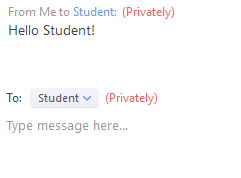
Learn how to create and run polls in a Zoom meeting.
For detailed information visit Zoom's Support Page on "Polling for Meetings".
The polling button in the meeting toolbar allows you to create multiple choice polling questions for your meetings. You will be able to launch the poll during your meeting and gather the responses from your attendees. You also have the ability to download a report of polling results after the meeting.
Note: Currently during the meeting you are not able to see how each individual responded to the poll. You can see it in the reports after the meeting is over. This request to see how individual responded during a meeting has been made and will be a feature in the near future.
When you are in the meeting, to create and add a poll, click on the Polls button in the meeting toolbar.

The poll window will appear. Click on Add a Question button.
This will launch the Zoom web portal in a browser where you can create your poll.
When you go back into the Zoom meeting you will see your poll you just created. To launch the poll to all of the meeting participants click the Launch Polling button. When the poll is launched the participants can then begin responding. When they submit their answers you will see the results of how the overall group responded to the poll questions. When you are ready to close the poll, click the End Polling button. Once the polling has ended, you as the host have the option to share the results with the rest of the participants. To share results, click the Share Results button. If you want to re-launch the poll because maybe not everyone was able to respond in the time allotted you can click the Re-launch Polling button.
Learn the ins and outs of utilizing breakout rooms in Zoom.
For additional information visit Zoom's Support Page on "Managing Breakout Rooms".
Breakout rooms allow you to split your Zoom meeting in up to 50 separate sessions. The meeting host can choose to split the participants of the meeting into these smaller groups automatically or manually, and can switch between session at any time. Breakout room participants have full audio, video and screen share capabilities. You can also pre-assign participants to breakout rooms when you schedule your meeting instead of doing it live during the meeting.
Limitations
Learn how to create and manage breakout rooms during a meeting.
The instructions below will walk you through how to create breakout rooms while you are within a Zoom meeting.
For more detail and further instructions, visit Zoom's support page on Managing breakout rooms.

2. Select the number of rooms you would like to create, and how you would like to assign your participants to those rooms. Selecting Automatically will let Zoom split your participants up evenly into each of the rooms. Selecting Manually will allow you to choose which participants you would like in each room. When finished selecting those options, click Create Breakout Rooms.
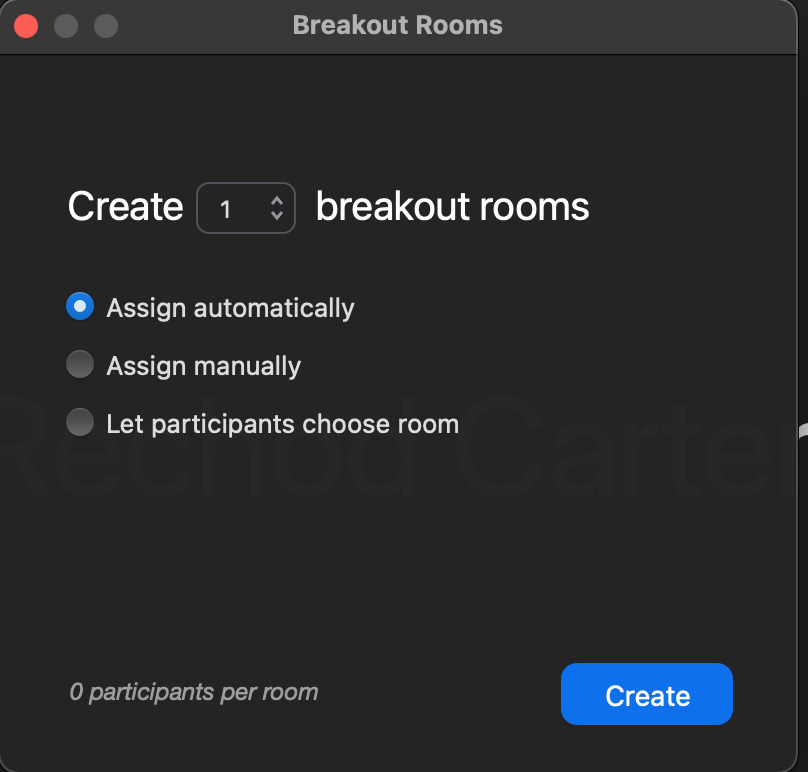
3. If you choose for Zoom to automatically assign the participants to the room, that will occur instantaneously. If you choose to manually assign participants to the rooms you will now have to assign them to the rooms. To do so, select the Assign link next to the room you wish to assign participants to and select the checkbox next to each participant you wish to assign to that room.
4. Once you are finished assigning participants to the rooms and are ready to begin the breakout rooms, click the Open All Rooms button.
Learn how to pre-assign breakout rooms ahead of your Zoom meeting.
If you want to assign your breakout rooms ahead of your meeting you can do that. Right now you can only do this from within the Zoom Web Portal. You cannot pre-assign breakout rooms from within your D2L course (Navbar > More > Portals >Zoom). From within the web portal you will access your meeting and edit the meeting. You'll have two options after selecting the "Breakout Room pre-assign" feature for the meeting. You can create the breakout rooms and assignments manually by hand from within the web portal OR you can use a CSV file and import it to your meeting. For small classes doing it manually by hand is manageable but if you have classes of 50 or more this can be a tedious process of entering emails in one at a time.
For more detail and further instructions, visit Zoom's support page on Pre-assigning participants to breakout rooms.
Note: If you are editing a recurring Zoom meeting and pre-assigning breakout rooms you need to make sure you choose "Edit All Occurrences" when it asks you what you want to edit. You cannot pre-assign breakout rooms to just ONE instance of a recurring meeting. It won't save your pre-assigned rooms if you choose "Edit this Occurrence".
Pre-assign participants to breakout rooms using the web portal (manual process)
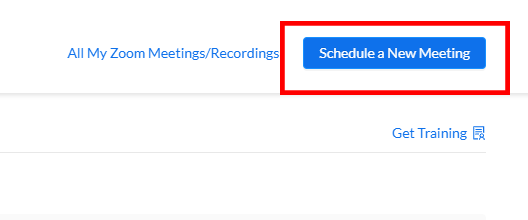
4. In the Meeting Options section, select Breakout Room pre-assign and click Create Rooms.

5. Click the + icon beside Rooms to add breakout rooms.
6. Hover over the default breakout room name and click the pencil icon to rename it if desired.
7. In the Add participants text box, you can search for participants' name by entering the full first and last name or just type their AU email address (netid@augusta.edu) and press Enter on your keyboard to add them to the breakout room. You can only add internal AU Zoom users here. To pre-assign participants that are outside our AU Zoom account you will need to import via a CSV file.
8. Click Save to save your breakout room pre-assignments to your meeting.
For larger courses and to pre-assign users that are outside of our AU Zoom account you will want to use a CSV file. The steps below will walk you through downloading the CSV template file, formatting the CSV file, and applying it to your meeting.
Step 1 - Download CSV template file from Zoom

5. Click download to download a sample CSV file you can fill out.
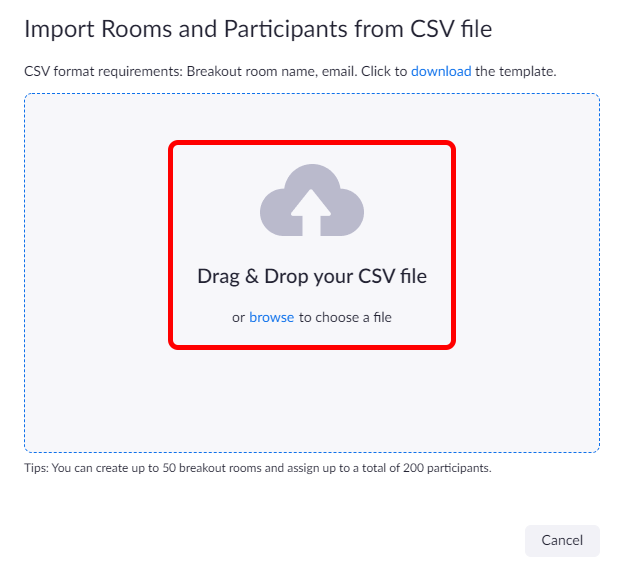
6. Open the CSV file with spreadsheet software like Microsoft Excel or something comparable.
7. Fill in the Pre-assign Room Name column with the breakout room name, and the Email Address column with the assigned participant's email address. You can copy/paste student's email addresses from a course roster that you previously downloaded or use data from another list you have. Important: When assigning participants, make sure you use their "@augusta.edu" email address. Also, DO NOT alter the names of the column headers "Pre-assign Room Name and Email Address". These need to be left as is or else you will get errors when attempting to upload the file to your meeting.
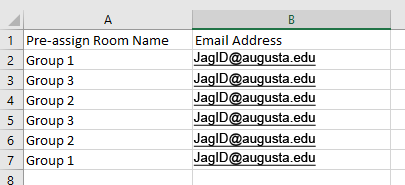
8. Save the file in CSV format. DO NOT save it as a normal Excel file. It needs to specifically be in CSV format.

9. Drag and drop the CSV file or browse to find the CSV file on your computer to import it into your meeting within the web portal. Zoom will verify that the email addresses all have a Zoom account.

10. Zoom will verify that the email addresses all have a Zoom account. You should then see all of our breakout rooms in the left panel and when you click on each room you will see the participants you have assigned to those rooms. Click Save.
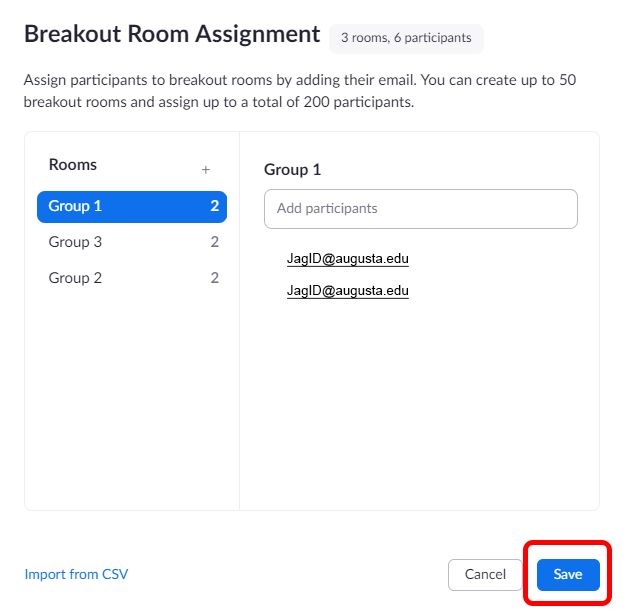
11. Click Save again to save your meeting. Now, once you are within your meeting then you will click on the Breakout Room button in the Zoom toolbar to bring up your assigned breakout rooms and to then Open All Rooms. If some students don't happen to get pre-assigned properly then you can manually assign them prior to opening the rooms. Likely reasons why participants don't get properly assigned to rooms is that they don't login to the Zoom application with their AU Zoom account therefore Zoom doesn't see their AU email address to properly put them in the assigned room. To properly login to the Zoom app please view instructions on How to sign into zoom.augusta.edu.
If during your meeting you click on the breakout room button in the Zoom toolbar and click on the Open All Rooms button in the breakout room window and you find that a participant has not been assigned to a room you can manually assign them to a room.
Learn how to record your Zoom Meetings.
For detailed information visit Zoom's Support Page on "Cloud Recording".
If you want to record your meeting you will have the option to record the meeting locally onto your computer or record to the cloud. Cloud recording is the default recording option for all faculty and staff accounts. Students will only have the option to record locally.
Enabling Cloud Recording for your Zoom Account
1. Log into zoom.augusta.edu.
2. Click on Settings on the left hand side.
3. Click on the Recordings tab and select if you want to record locally or on cloud.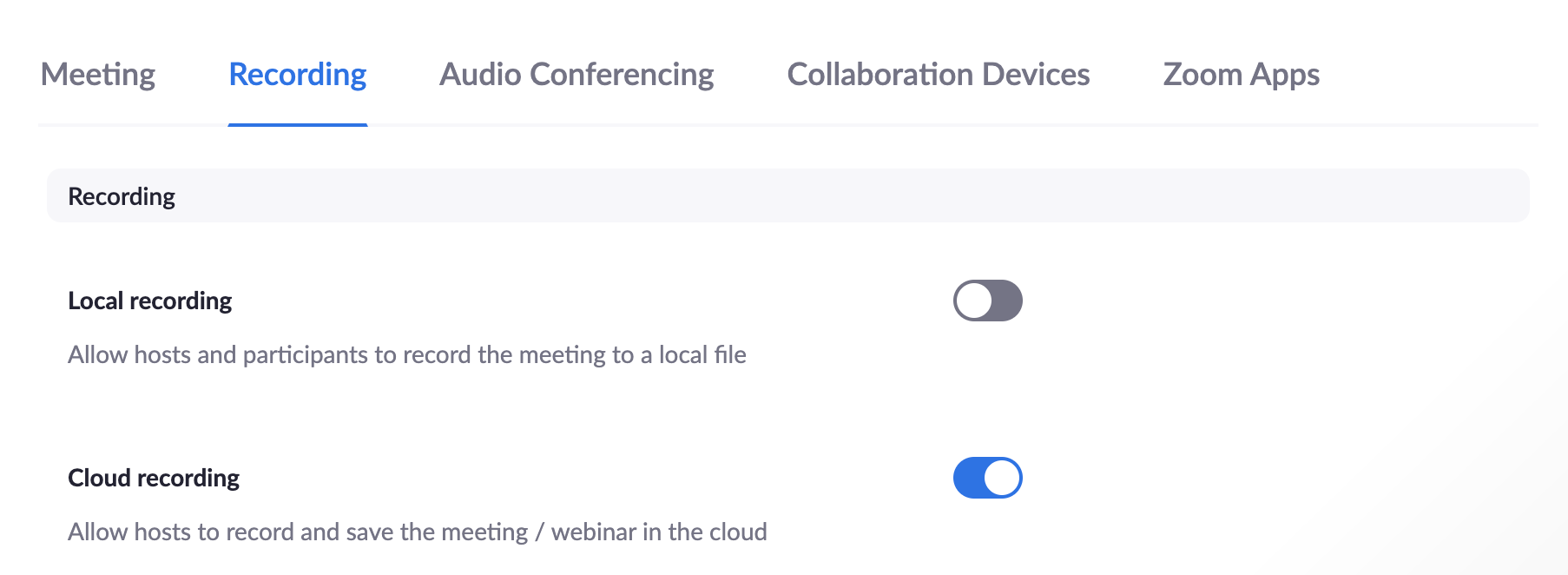
Record to Your Computer (Local Recording)
Local recording allows users to record meeting video and audio locally to their computer. The recorded files can then be uploaded to file storage websites like Box or Google Drive.
Start a Local Recording

2. A menu prompt will appear, select Record on this Computer.
3. Hosts will see the following recording indicator in the top left corner when the recording has started.
4. In the participants window it will also display a recording indicator next to the user who is actively recording.
5. Once the meeting has ended, a prompt will appear stating "You have a recording that needs to be converted before viewing." Wait for the recording to convert before it can be accessed. Note: If the meeting unexpectedly shuts down or the conversion process is interrupted, the recording files could become corrupted and non-recoverable.
6. Once the conversion process is complete, the folder containing the recording files will automatically open.
Recording File Formats,
Cloud Recording
When you record a meeting a choose Record to Cloud, the video, audio, and chat text are recorded in the Zoom Cloud. The recording files can then be downloaded to a computer or streamed from a browser via HTML5 or Flash. Please note: Students will not have the capability to record to the cloud, they are only able to record locally.
Start a Cloud Recording
Once the recording has been stopped, the recording must be processed before viewing. Zoom will send an email to the host email address when the processing is completed. In that email will be links to view the recording as well as share the recording with others.
Learn how to adjust your Zoom Cloud Recording Settings.
Within Zoom, you may want to adjust the cloud recording settings to receive the correct format of recording that you desire. By default, your account likely will render the following types of recordings:
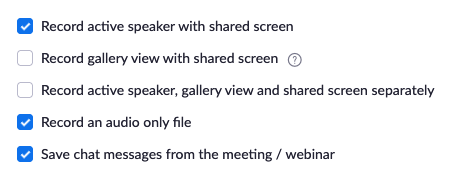
Learn how to access and export meeting and poll reports.
There are a few different types of reports that you can access regarding your Zoom meetings, a Meeting Report and a Poll Report. A meeting report will tell you who attended your meeting, what time they joined, what time they left, and for how long they were in your meeting. A poll report will show you the specific results of your polls that you run in your meeting and how each participant responded.

4. Select Report for which meeting you want to view a report.
5. You will see two tabs, a Meeting Report tab and a Poll Report tab.

6. The Meeting Report tab will show you your meeting attendance information. You can export these results to CSV if you desire.
7. The Poll Report tab will show you your results from the polls you conducted during the meeting. You can export these results to CSV if you desire.
